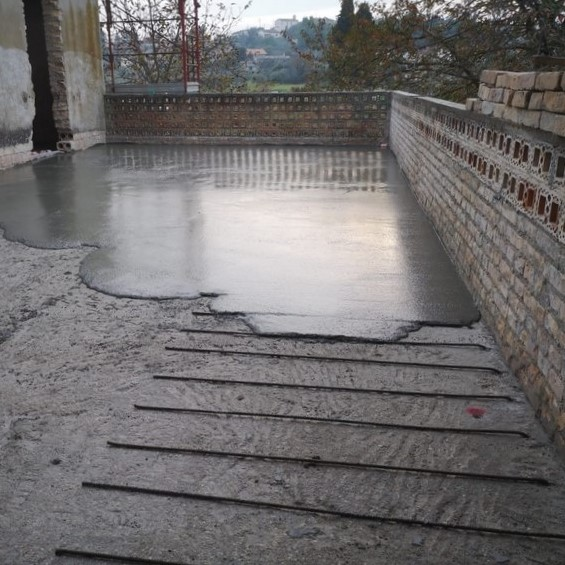



The rheological and physical-mechanical characteristics of the Rinfor Grout Col product render it extraordinarily effective in reinforcing structural elements in reinforced concrete and masonry. Adhered to the inside of caissons, confined within cavities or spread out over the extrados of foundations and lofts, Rinfor Grout Col allows for low thickness structural reinforcing, substantially devoid of additional metallic reinforcement. Rinfor Grout Col belongs to the HPFRC (High Performance Fibre Reinforced Concrete) family, permitting the structural designer to make use of the following characteristics: - Exceptional resistance and traction as well as exceptional values of shear stress adhesion on various supports which have been suitably roughened; - advantages in structural calculations prescribed for fracture mechanics, resistance to traction and of the ultimate material deformation; - minimum thicknesses applied with reinforcing effects which have been distinctly improved as against interventions with traditional reinforced concrete; - highly notable reduction of mass and minimizing of additional loads applied for structural reinforcing as against interventions with traditional reinforced concrete (practically nil additional loads in the case of the thickness of the coating corresponding with the depth of sacrificed surface); - anti-carbonatation barrier (practically zero penetration of CO2) and anti-oxidant barrier; - auto-healing of any micro-fissures exposed to contact with fluids, thanks to the particular crystallising additives; - increment of durability of the structures repaired with Rinfor Grout Col, thanks to the migration effect of the crystallising additives; - very high resistance to fire; - eco-sustainability - made up of 100% mineral and metallic materials, totally recyclable at end of life. From the environmental point of view, the Rinfor Grout Col product is characterised by the following advantages: - Ecological packaging (card-cardboard) - product based on hydraulic binders, selected aggregates and mineral additives with content of organic raw materials < 1% - practically nil VOC emissions during installation; once hardened, nil VOC emissions. - containing a fraction > 5% of sub-products from the production industry 100% recyclable at end of life.
- For seismic adaptation with absorption and transfer of pressure or traction during events with elevated dynamic forces (seismic, impacts, deflagration); - for structural reinforcing and seismic upgrading through coating of beams, pillars structural ties, walls; - for reinforcing and seismic upgrading with external, low thickness, structural screed for lofts in reinforced concrete, concrete masonry, corrugated sheeting, wood; - for fabrication of light, thin section, structural elements ; - for the repair of flooring with need for resistance against elevated static and dynamic stresses, together with exceptional values of resilience and resistance to impacts; - for reinforcing and precision anchoring of heavy and highly stressed machinery: E.g. wind turbines, turbines, precision machinery, etc.
The support must be in good condition, clean, sufficiently coarse, without crumbling parts or dust, pressure washed and saturated with water before application. With concrete, the abrasiveness of the support must be > 3mm; to obtain this level of coarseness, techniques of hydro-scarifying, bush-hammering, mechanical chiselling, sand blasting with large grain may be considered. With the case of surfaces in strongly absorbent brick-work (lofts in brick cement with surfacing of parts in brick) or in the case in which it is impossible to saturate the support with water, contact our technical services to evaluate suitable adhesion primers, such as Syntech Pavisheer or Syntech RGS. Above all, when used as a surface covering of lofts in concrete, or as a repair to industrial flooring, providing anchoring roots by drilling the support is particularly useful for increasing resistance to cuts and adhesion to the support (diameter 18-20 mm, depth 20 mm), and accurately cleaning the surfaces of the holes before spreading the Rinfor Grout Col.
With regard to pouring in summer weather (hot, arid, windy) or in winter climates (cold, windy, frigid temperatures around 0C) all the prescriptions and recommendations notified in the STRUCTURAL CONCRETE GUIDE LINES (Ministry of Public Works) are valid. For coating, to reinforce beams structurally, pillars, ties, etc., use reinforced casings given the strong pressure exerted by the product, Use an efficient mixer with vertical axis (or efficient drill with mixing head for mixing a single pack in a bucket). Mix with effective vertical axis mixers for not less than 8-9 minutes.
For caisson pours, aid the filling process with light tapping with a rubber hammer on the caissons.
For pours in lofts, help the spreading and levelling with spreaders and cover the casts as soon as possible with waterproof canvas or with anti-evaporation coverings such as QL Nano Lithium.







Compressive strength at 2 days
UNI EN 12190
Compressive strength after 7 days
UNI EN 12190
Compressive strength after 28 days
UNI EN 12190
Flexural strength after 7 days
UNI EN 196/1
Flexural strength after 28 days
UNI EN 196/1
Compressive strength
UNI EN 12390-3
Breaking load longitudinal
UNI 6135
Measuring the flexural tensile strength (limit of proportionality, residual) fr1k (gap opening 0.5 mm)
UNI EN 14651
Measuring the flexural tensile strength (limit of proportionality, residual) fr3k (gap opening 2.5 mm)
UNI EN 14651
fr3k / fr1k ratio
UNI EN 14651
Toughness class EN 14651
UNI EN 14651
Shear strength
metodo del cuneo a 45°
Adhesion to substrate
UNI EN 1542
Access for traffic light
a 20 °C
Access with maximum stress
Thermal conductivity
UNI EN 12664
Static elastic modulus
EN 13412
Walkability
a 20 °C
Water penetration depth
Removal of formworks
Endogenous withdrawal
Free-phase withdrawal/expansion
T 20 °C e U.R. 50%
Total recycled content
UNI PdR 88:2020
Approximately 22 kg/m² of Rinfor Grout Col for every centimetre of thickness to be implemented (approximately 2200 kg per cubic metre).